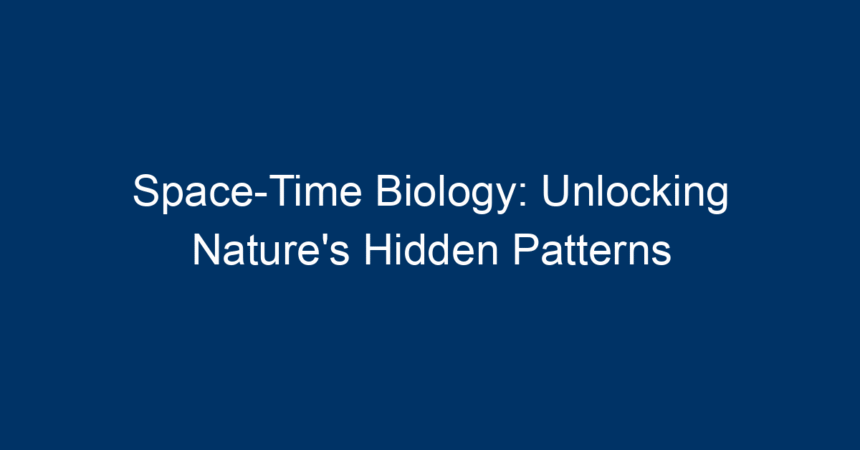The intertwining of space and time has been a subject of fascination for centuries, captivating not only physicists but also biologists who seek to understand the complexities of life itself. Space-time biology emerges as a cutting-edge discipline exploring how the dimensions of space and time intersect with biological processes. What if the patterns of nature are not merely random occurrences but a dance influenced by spatial and temporal factors? In this article, we’ll delve deeper into the realm of space-time biology, revealing its profound implications for science and society.
Understanding Space-Time Biology
What is Space-Time Biology?
At its core, space-time biology investigates the relationships between living organisms and their environments across spatial and temporal scales. This interdisciplinary field marries principles from biology, physics, and mathematics, seeking to uncover underlying patterns that dictate the behaviors, interactions, and evolution of life forms.
The Historical Context
The quest to understand biological phenomena in a spatial and temporal context isn’t entirely new. Theories dating back to Charles Darwin’s evolutionary biology hinted at time’s role in the adaptation of species. However, the rise of computational models and advanced statistical techniques has prompted a renewed interest. The dynamic interplay between space and time in ecological systems offers a wealth of information necessary for understanding evolutionary patterns and predicting future ecological changes.
The Key Concepts of Space-Time Biology
Spatial Dynamics
Spatial dynamics examines how organisms and ecosystems are distributed across geographical areas. Factors such as habitat fragmentation, resource availability, and human interventions influence these distributions. For instance, the spread of invasive species often hinges on their ability to navigate through various landscapes and climatic conditions.
Case Study: The Spread of COVID-19
The recent COVID-19 pandemic serves as a prime example. By analyzing the spatial spread of the virus, researchers were able to track its movement through major cities and rural areas. Understanding these spatial patterns helped policymakers implement effective containment strategies, including lockdowns and social distancing measures.
Temporal Dynamics
Temporal dynamics looks at how biological processes evolve over time. This includes life cycles, seasonal behaviors, and evolutionary adaptations. By studying these time-based patterns, researchers gain insight into phenomena such as migration, breeding cycles, and population dynamics.
Example: Animal Migration
Consider the remarkable migratory patterns of birds. These migratory behaviors are not only tied to seasonal changes but also influenced by factors such as climate and food availability. By mapping these migrations across different time frames, scientists can better predict changes in species populations and adjust conservation strategies accordingly.
The Role of Technology
Modern technological advancements, including GPS tracking, satellite imagery, and machine learning, have propelled the study of space-time biology to new heights. With these tools, researchers can gather and analyze massive datasets that reveal intricate patterns of life’s interactions with space and time.
Applications of Space-Time Biology
Conservation Efforts
One of the most significant implications of space-time biology lies in its application for conservation. By understanding how biodiversity evolves in specific spatial and temporal contexts, conservationists can devise targeted strategies to protect endangered species and ecosystems.
Example: Habitat Preservation
For instance, knowing the migratory routes of endangered birds allows conservationists to create protected areas along these paths, ensuring their survival. Additionally, by predicting changes in migratory patterns due to climate change, organizations can proactively address potential threats.
Urban Planning
As urban environments continue to expand, space-time biology provides planners with valuable insights. By understanding how different species interact with urban ecosystems over time, city planners can design spaces that promote biodiversity and ecological sustainability.
Example: Green Infrastructure
Implementing green roofs, parks, and urban gardens can help mitigate the negative impacts of urbanization on local wildlife. Space-time biology provides a framework for assessing how these green spaces can be effectively integrated into urban settings.
Health and Disease Management
The principles of space-time biology also extend into human health. Understanding how diseases spread through populations over time and space can enhance efforts to manage outbreaks. Timely interventions, informed by spatial data and historical patterns, can save lives and resources.
Challenges in Space-Time Biology
Data Complexity
Despite its potential, space-time biology faces challenges, primarily stemming from the complexity of data collection and analysis. Accurately capturing the interplay of biological and ecological variables requires sophisticated modeling techniques and robust datasets.
Interdisciplinary Collaboration
Effectively conducting research in space-time biology necessitates collaboration across diverse fields. Biologists, ecologists, physicists, and data scientists must work together to decipher the intricate patterns of life.
Ethical Considerations
As with any scientific advancement, ethical considerations arise. The manipulation of biological systems can have unintended consequences, making it essential for researchers to navigate these complexities responsibly.
Future Directions in Space-Time Biology
Advancements in Artificial Intelligence
Artificial intelligence (AI) promises to revolutionize space-time biology by enhancing data analysis capabilities. Machine learning algorithms can identify patterns that may elude human researchers, paving the way for groundbreaking insights.
The Rise of Citizen Science
Involving the public in space-time biology research can enrich datasets and broaden participation. Citizen science initiatives, where volunteers help gather data on biodiversity, can contribute significantly to our understanding of ecological dynamics.
Improved Climate Models
As climate change continues to reshape our planet, enhanced climate models informed by space-time biology will be crucial in predicting ecological shifts. By studying how organisms adapt to these changes, scientists can develop strategies that promote resilience.
Conclusion: Embracing the Patterns of Life
In a world increasingly defined by rapid change, understanding the intersection of biology with space and time offers invaluable insights. Space-time biology is not just a scientific curiosity; it provides essential tools for addressing some of humanity’s most pressing challenges in conservation, urban planning, and health.
Actionable Insights
- Get Involved: Participate in citizen science projects to contribute to our understanding of local ecosystems.
- Stay Informed: Follow developments in space-time biology to appreciate its implications for our world.
- Advocate for Sustainability: Support initiatives that promote sustainable urban planning and wildlife conservation.
By recognizing and embracing the hidden patterns of nature, we not only deepen our understanding of the biological world but also equip ourselves to create a more sustainable future.




